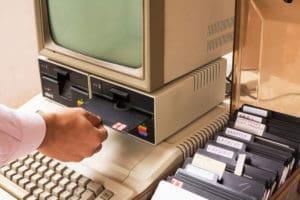 For many of us, our first introduction to the computer was an Apple II, whether playing Oregon Trail in the school computer lab or as one of the lucky few who owned this remarkable personal computers. Designed by Steve Wozniak and made available for sale June 5, 1977, the Apple II put Apple on the map due to its self-contained structure, floppy disk drive, and compatibility with pioneering spreadsheet program VisiCalc. The price was $1,298, or approximately $5,492 in 2020 dollars.
For many of us, our first introduction to the computer was an Apple II, whether playing Oregon Trail in the school computer lab or as one of the lucky few who owned this remarkable personal computers. Designed by Steve Wozniak and made available for sale June 5, 1977, the Apple II put Apple on the map due to its self-contained structure, floppy disk drive, and compatibility with pioneering spreadsheet program VisiCalc. The price was $1,298, or approximately $5,492 in 2020 dollars.
Historic new capabilities
Wozniak explained his vision in Byte magazine: “To me, a personal computer should be small, reliable, convenient to use, and inexpensive.” Now archived at the Smithsonian, the Apple II relied on BASIC in permanent memory and could support color graphics on its TV monitor. The base unit had 4 KB RAM, but its RAM could be expanded up to 48 KB. The motherboard offered eight expansion slots, giving computer hobbyists the chance to add video cards and other enhancements. (Watch an Apple II in action here.)
By 1984—when Apple introduced the Macintosh—the company had sold more than two million Apple IIs. If you have one kicking around, hold on to it. In 2015, an Apple II with two original disk drives and an intact motherboard sold for $4,687 at auction. That’s impressive until you hear that the more rare Apple I, which Wozniak designed with hobbyists in mind rather than consumers, is worth up to $475,000 depending on condition.
Photo: Angelo DAmico / Shutterstock
